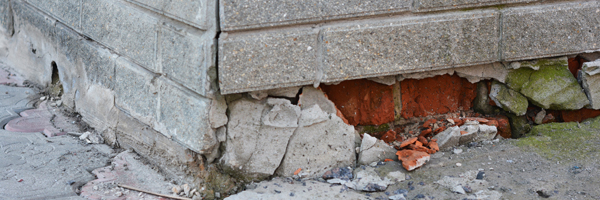
Foundation cracks can be an alarming discovery inside or outside your home. A crack in foundation slab or basement walls may leave you worrying if your home structure is in good shape.
We’ve gathered the basic information you need to know about foundation cracks and repairs. Learn when to worry about cracks in your foundation and consider hiring a professional to take a look. We’ll also cover different types of foundation and the leading causes of foundation ruin so you’re ready to pinpoint problems in your home. Let’s get started!
Different types of foundation
Building styles for homes vary by geographical location and weather-based needs. For instance, homes in Southern, coastal states typically do not have basements because of hurricane and flood risks. In Midwest states like Ohio, Wisconsin and Michigan, homes with basements are common.
In a similar way, home foundations also vary based on structural, geographical or weather-based needs. Here are some of the most common types of foundations:
- Concrete slab foundation—Also known as a monoslab foundation, this is one single piece of flat concrete slab. These types of homes do not have crawl spaces and they aren’t common in colder climates because cracks can form from the surrounding earth freezing and warming up.
- Basement foundation—A foundation at least eight feet in the ground to support a basement under a home. These foundations are built beneath the frost line to prevent shifting during seasonal changes.
- Crawl space foundation—Also known as stem walls, this type of foundation is for homes with crawl spaces. Crawl space foundations are common in warmer regions and offer protection from flooding. Builders often choose crawl space foundations for homes in earthquake zones.
Leading causes of foundation cracks
If you’re wondering where the crack in your house foundation came from, one of these may be the cause:
- Soil expansion—Backfill soil, also known as expansive soil, surrounding your home is more likely to absorb water and push against your foundation than other soil types.
- Severe storms—Heavy rainfall can leave water sitting around your foundation, causing soil expansion and foundation cracks.
- Street creep—This happens during warmer months when your street expands, pushing your driveway into your foundation.
- Tree roots—A tree that’s close to your home can damage the structure when roots push against the foundation to absorb water.
- Foundation settlement—While this typically happens in the first few years after a home is built, a foundation can continue to settle depending on the integrity of the surrounding soil.
- Earthquakes—When shifting tectonic plates form a seismic wave, or an earthquake, your foundation can shake and shift out of place.
- Frost heave—This happens when the ground temperature surrounding your home drops below 40 degrees Fahrenheit and the freezing soil expands upward.

Learn about our
Home Insurance
4 types of foundation cracks
The direction and size of foundation cracks can be an indicator of an underlying structural issue. The four primary types of foundation cracks are:
1. Natural curing
This is a type of cosmetic foundation crack. Usually, newer homes get small or hairline cracks after the concrete foundation is completely free of moisture.
2. Vertical
These cracks are typically caused by shrinkage or compression from soil expansion. Many homes have vertical cracks in the foundation.
3. Stair step
This type of crack zigs and zags along the cinder blocks of foundation walls. These cracks can indicate there is uneven settlement around a home foundation.
4. Horizontal
These cracks are caused by soil expansion against foundation walls, forcing the walls to cave inward. They typically form when the surrounding soil is heavily saturated with water and then a deep freeze occurs.
Signs you need foundation repair
Not every crack in the foundation floor or wall will require repairs. However, you should call a professional contractor to look at splits or separation in your foundation if:
- Foundation walls are bowing
- Water isn’t draining properly away from your foundation
- Moisture is present in your crawl space or basement
- Your floors are slanted or sagging
If you notice any of these signs of foundation issues, it’s time to hire a professional contractor for foundation repairs.
Are cracks in your foundation covered by insurance?
It depends on what caused the crack in the foundation floor or wall and what types of insurance you have. The Insurance Information Institute says your homeowners insurance policy typically covers damage or ruin from fire, hail, lightning, hurricane or other natural disasters that are stated in your policy. However, damage from flood waters will require flood insurance. Similarly, earthquake insurance will cover damage or destruction from an earthquake. Talk to your agent today to learn more about your insurance coverage for foundation repair.
Choose Integrity for home coverage you can count on
Protect your home and property with help from Integrity Insurance. From discounts to customizable options, we offer the protection to meet your needs and budget.
Talk to an independent agent today to learn more about our home insurance coverage.
This article is for informational and suggestion purposes only. Implementing these suggestions does not guarantee coverage. If any policy coverage descriptions in this article conflict with the language in the policy, the language in the policy applies. For full details on Integrity’s home insurance coverages and discounts, contact your local independent agent.
Sources:
Eden Structural
MT Copeland
Ohio Basement Authority
Helitech
NV Waterproofing